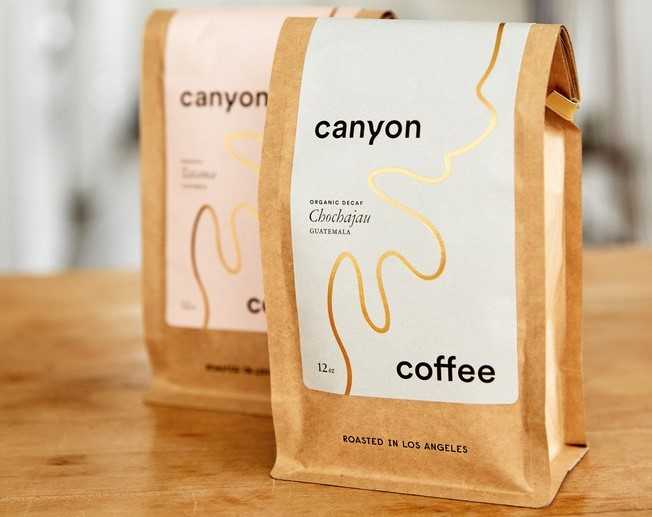LOS ANGELES, U.S. – “We both travel a ton and love finding local coffee roasters and cafes whenever we are away,” says Ally Walsh, one half of the couple behind Canyon Coffee, a buzzy new organic, sustainably sourced coffee brand based out of Los Angeles.
“But what we most look forward to is coming home, making coffee for each other, and drinking it together.”
See, while your Instagram feed has been saturated with rainbow, unicorn, and adaptogenic turmeric lattes (many of which don’t even contain coffee), devoted drinkers have been filtering out the noise and going back to basics with single-origin beans, brewed pour-over style and served black—“Great coffee should taste great black or it’s missed the mark,” says Walsh.
It was a shared love of this elegant approach that led Walsh, a model, and her boyfriend and business partner, Casey Wojtalewicz, a drummer in the indie rock band Wildling, to create Canyon Coffee. “We realized we were seeing all these cool coffee accessories in boutiques, but no beautiful coffee to go with it,” Walsh recalls.
The pair decided to source their own beans with the help of speciality coffee importer Olam Coffee and local roaster James Klapp, and packaged it up in a chic bag with a meandering rose gold foil line inspired by the rugged canyon landscape of Los Angeles.
Since launching in October of last year, the pair have created three roasts—a Chochajau Guatemala medium roast, a Tatama Colombia medium roast, along with a Swiss Water Process decaf version of the Chochajau for coffee lovers who don’t love caffeine—and gained a fashionable following—they are sold everywhere from CAP Beauty and Clover Grocery in New York City, to General Store in San Francisco and Individual Medley in L.A.
“We are roasting over 150 lbs. of beans a week now,” says Walsh. Next up? A launch at ABC Carpet & Home and L.A.’s haute health food chain Erewhon Market. “One day we want to open a coffee shop and teach people how to make the perfect cup of coffee,” says Walsh. Until then, here is Canyon Coffee’s guide to how to do it yourself.
The equipment
“If you were to ask us what the single most important investment should be to elevate your home coffee game, we would say a burr grinder. Burr grinders, as opposed to blade grinders, grind the coffee more evenly and consistently. We use a Baratza Encore at home and have a Hario burr hand grinder for travel or camping trips. In terms of how finely you should grind your coffee, it depends on how you’re going to brew it: The longer your coffee is going to be in contact with water, the coarser you can grind it, so if you are using a french press you want a course grind; for pour over, a medium grind; and coffee for an espresso needs to be ground very finely. We like making coffee pour over style and use a Hario V60 Coffee Dripper with our beautiful live edge, black walnut pour over stand. The great thing about the V60 is that you can also travel with it. I grind coffee in advance and bring it with me, along with a reusable hemp filter that can be rinsed in a hotel sink.”
The coffee
“Organic, sustainably grown, single origin, whole bean, and freshly roasted—this is what we look for when we buy coffee. Look for a roasting date on the bag and words like single estate or single farm, meaning that it has been sourced from one single producer, crop, or region in a country rather than a blend of many different beans.”
The water
“Use an electric kettle with a digital display and temperature control and set it to 203 degrees Fahrenheit. You don’t want to pour boiling water (212 degrees Fahrenheit) on your coffee as it can burn or over-extract the coffee and make it taste bitter. If you don’t have one, let the water cool for 30 to 60 seconds after it boils before pouring over your coffee.”
The coffee-to-water ratio
“The basic rule is that the average 6 oz. mug of coffee takes around 12 grams of beans. If you don’t have a kitchen scale, this conveniently equates to one scoop per cup using the spoon that comes with Hario V-60.”
The bloom
“A coffee ‘bloom’ is the release of gases, oils, and aromatics within the beans that happens when hot water comes in contact with the coffee grounds. If your coffee doesn’t bloom it means the beans are not very fresh and have already ‘degassed’. Generally speaking, the bigger the bloom, the fresher the roast. Measure out your coffee into the filter and then slowly pour a little bit of water on the grounds—just enough to get them all wet. Stand back and watch your coffee bloom as the CO2 gas is released from the beans and bubbles up to form a dome. After 30 seconds, slowly pour the rest of the water over the beans starting in the center and working out in a spiral motion.”
Rachel Marlowe


















